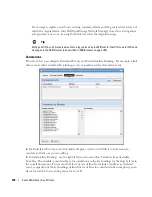
118
Event Processing Rules | Key Portlets
Trap Forwarding Process
SNMPv1 and SNMPv3 traps become SNMPv2 Traps
SNMPv1 traps are converted according to RFC 1908. SNMPv3 traps are already in SNMPv2 format
and the application simply does not use SNMPv3 security when sending these northbound. The
following is the relevant snippet from RFC 1908:
3.1.2. SNMPv1 -> SNMPv2
When converting responses received from a SNMPv1 entity acting in an agent role into
responses sent to a SNMPv2 entity acting in a manager role:
(1) ...
(2) If a Trap-PDU is received, then it is mapped into a SNMPv2-Trap-PDU. This is done by
prepending onto the variable-bindings field two new bindings: sysUpTime.0 [6], which takes
its value from the timestamp field of the Trap-PDU; and, snmpTrapOID.0 [6], which is
calculated as follows: if the value of generic-trap field is
enterpriseSpecific
, then the
value used is the concatenation of the enterprise field from the Trap-PDU with two additional
sub- identifiers, ‘0', and the value of the specific-trap field; otherwise, the value of the
corresponding trap defined in [6] is used. (For example, if the value of the generic-trap field is
coldStart
, then the application uses the coldStart trap [6]) Then, one new binding is
appended onto the variable-bindings field: snmpTrapEnterprise.0 [6], which takes its value
from the enterprise field of the Trap-PDU. The destinations for the SNMPv2-Trap-PDU are
determined in an implementation-dependent fashion by the proxy agent.
Despite this description, many vendors defined a trap for SNMPv2 and then had to support
sending as SNMPv1 protocol. The assembly of v2 OID from v1 enterprise and specific is supposed
to include an extra ‘0'; enterpriseOID.0.specific. However, if a v2 trap is defined that has no '0' in it,
so it cannot be sent as v1 and converted back following the specifications
Send as Proxy
This application can forward a trap as though it came from device (sourceIP spoofing) or act as an
agent proxy according to the SNMP-COMMUNITY-MIB.
If not sending as proxy, we forward trap from application server cluster as an SNMPv2 notification
as though it is coming directly from the originating agent (device). This is a common and desired
behavior. Some operating systems prevent packet spoofing as a security measure so this behavior is
necessarily optional.
Summary of Contents for OpenManage Network Manager
Page 1: ...Dell OpenManage Network Manager version 5 1 Web Client Guide ...
Page 14: ...14 A Note About Performance Preface ...
Page 98: ...98 Schedules Portal Conventions ...
Page 142: ...142 Vendors Key Portlets ...
Page 232: ...232 File Management File Servers ...
Page 242: ...242 Deploy Configuration ...
Page 290: ...290 Key Metric Editor Monitoring Metrics This panel s display depends on the selected device ...
Page 340: ...340 ...
Page 374: ...374 Adaptive CLI Records Archiving Policy Actions and Adaptive CLI ...
Page 380: ...380 Glossary ...
Page 388: ...388 388 Index ...
















































